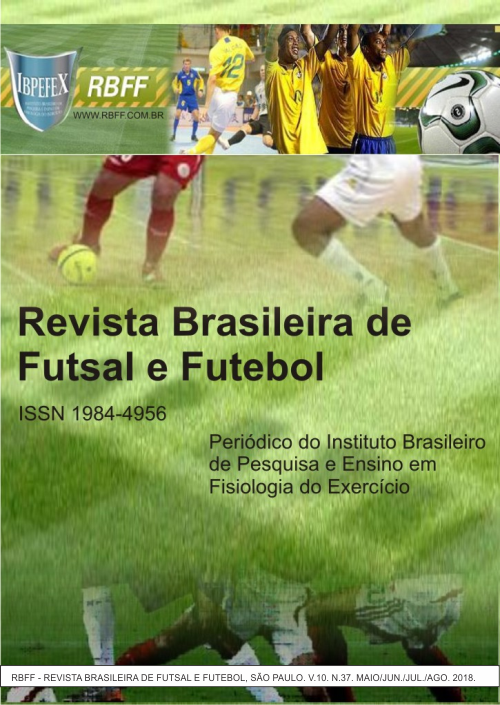Oxygen consumption of under-20 players during the preseason
Abstract
Football is a worldwide popular sport modality that requires a player to have a special set of skills and a high demand on aerobic and anaerobic energy metabolism. Because of match duration, this modality is mostly reliant on the aerobic system, so the majority of studies refers to the VO2max as it best represents the body's capacity to uptake, deliver and metabolize oxygen in energy production during muscle contractions. Given the importance of the VO2max to football, the present study aimed to verify the effects of a 7-week pre-season period on the VO2 max of juvenile football players. The sample was composed by 17 juvenile male athletes who were submitted to the Yo-yo Intermittent Recovery Level 1 before and after the pre-season. From the results of the present study, we conclude that after 7 weeks of pre-season the VO2maxwas increased in 15,8%. This value can be used by fitness coaches to estimate the necessary amount of time to attain the goals in VO2max in a pre-season.
References
-Al-Hazzaa, H. M.; Almuzaini, K. S.; Al-Refaee, S. A.; Sulaiman, M. A.; Dafterdar, M. Y.; Al-Ghamedia, A.; Al-Khuraiji, K. N. Aerobic na anaerobic Power characteristics of elite soccer players. Journal os Sports Medicine and Phiysical Fitness. Vol. 41. Num.1. 2001. p.54-61.
-Balikian Junior, P.; Lourenção, A.; Ribeiro, L. F. P.; Festuccia, W. T. L.; Neiva, C. M. Consumo máximo de oxigênio e limiar anaeróbio de jogadores de futebol: comparação entre as diferentes posições.Revista Brasileira de Medicina do Esporte. p. 32-36. 2002.
-Bangsbo,J. Yo-Yo tests. HO+Storm, Copenhagen, Denmark and TocanoMusic A/S, Smorum, Denmark. 1996.
-Bangsbo, J.; Norregaard, L.; Thorso, F. Activity profile of competition soccer. Canadian Journal Sports Science. Vol. 16. Num. 2. 1991. p. 110-116.
-Bangsbo, J.; Lindquist, F. Comparison of various exercise tests with endurance performance during soccer in professional players. International Journal Sports Medicine. Vol. 13. p. 125-32. 1992.
-Chamari, K.; Hachana, Y.; Kaouech, F.; Jeddi, R.; Moussa-Chamari, I.; Wisløff, U. Endurance training and testing with the ball in young elite soccer players. British Journal of Sports Medicine. Vol. 39. p. 24-28. 2005.
-Chin, M.K.; Lo, Y.S.A.; Mphil, C.T.L.; So, C.H. Physiological profiles of Hong Kong elite soccer players. British Journal of Sports Medicine. Vol. 26. Núm. 4. p. 262-266. 1992.
-Dantas, E. H., A prática da preparação física, 5º edição. Shape, 2003.
-Denadai, S. B. Índices Fisiológicos de avaliação aeróbia: conceitos e aplicações. Ribeirão Preto.B. S. D. 1999.
-Dvorak, J.J.A. Football injuries and physical symptoms: a review of the literature. American Journal of Sports Medicine. Vol. 28. Núm. 5. p. s3-9. 2000.
-Gallahue,D.L.Compreendendo o desenvolvimento motor: bebes, crianças, adolescente e adultos.: 3ª edição. São Paulo. 2005.
-Gil, S. M.; Gil, J.; Ruiz, F.; Irazusta, A.; Irazusta, J. Physiological and anthropometric characteristics of young soccer players according to their playing position: relevance for the selection process. Journal of Strength and Conditioning Research. Vol. 21. Num. 2. p. 438-445. 2007.
-Goulart, L.F.; Dias, R.M.R.; Altimari, L.R. Variação do Equilíbrio Muscular Durante uma Temporada em Jogadores de Futebol Categoria Sub-20. Revista Brasileira de Medicina do Esporte. Vol. 14. Núm. 1.p. 17-21. 2008.
-Helgerud, J.; Engen, L.C.; Wisloff, U.; Hoff, J. Aerobic endurance training improves soccer performance. Medicine Science Sports Exercise. Vol. 11. p. 1925-31. 2001.
-Moraes, M. V. L.; Herdy, C. V. S. H. Perfil do padrão médio do consumo máximo de oxigênio (VO2máx) na categoria sub-16 do Club de Regatas Vasco da Gama. Revista de Educação Física. Núm. 139. p. 119.2007.
-Ostojic, S. M. Physical and physiological characteristics of elite Serbian soccer players. Physical Education and Sport. Vol.1. Num. 7. p. 23-29. 2000.
-Reilly Tw, A.M.; Nevill, A. E.; Franks, A. A multidisciplinary approach to talent identification in soccer. Journal of Sports Science. Vol. 18. Núm. 9. p. 695-702. 2000.
-Santos, J.A.R. Estudo comparativo, fisiológico, antropométrico e motor entre futebolistas de diferente nível competitivo. Revista Paulista de educação Física. Vol. 13. Num. 2. p. 146-159. 1999.
-Silva, C.D.; Bloomfield, J.; Marins, J.C.B. A review of stature, body mass and maximal oxygen uptake profiles of U17, U20 and first division players in Brazilian soccer. Journal of Sports Science and Medicine. Núm. 7. p. 309-319. 2008.
-Stolen T, Chamari K, Castagna C, Wisloff U. Physiolog of Soccer-An Update. Sports Medicine. Vol. 35. Núm. 6. p. 501-536. 2005.
-Tahara, Y.; Moji, K.; Tsunawake, N.; Fukuda, R.; Nakayama, M.; Nakagaichi, M.; e colaboradores. Physique, Body Composition and Maximum Oxygen Consumption of Selected Soccer Players of KunimiHigh School, Nagasaki, Japan. Journal of Physiological Anthropology. Vol. 25. Núm. 4. p. 291-297. 2006.
Authors who publish in this journal agree to the following terms:
- Authors retain the copyright and grant the journal the right of first publication, with work simultaneously licensed under the Creative Commons Attribution License BY-NC which allows the sharing of the work with acknowledgment of the authorship of the work and initial publication in this journal.
- Authors are authorized to enter into additional contracts separately for non-exclusive distribution of the version of the work published in this journal (eg, publishing in institutional repository or book chapter), with acknowledgment of authorship and initial publication in this journal.
- Authors are allowed and encouraged to post and distribute their work online (eg, in institutional repositories or on their personal page) at any point before or during the editorial process, as this can bring about productive change as well as increase impact and impact. citation of published work (See The Effect of Free Access).





